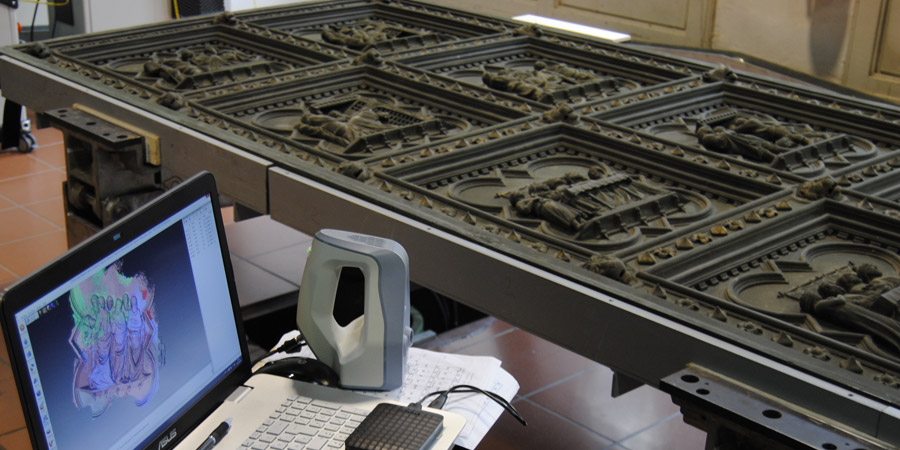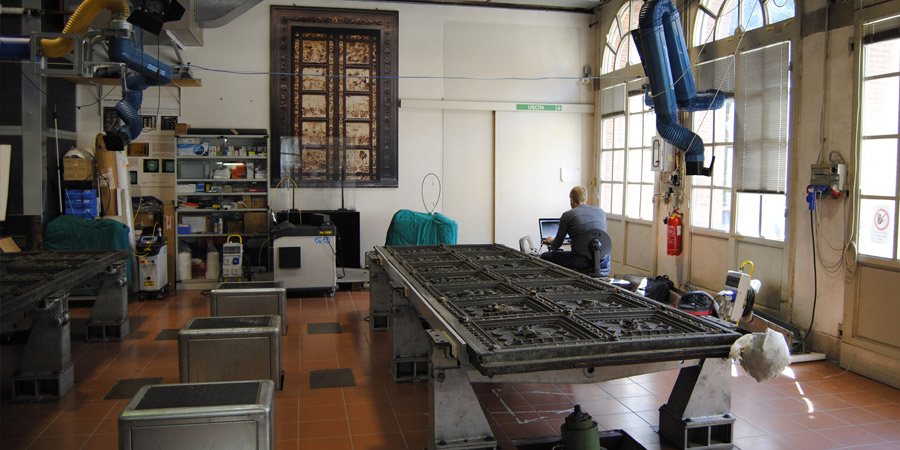In Italy, 3D printing and scanning technology has helped to restore the south doors of the Baptistery of Florence, built around 700 years ago.
Made from bronze, the doors were suffering from deterioration due to weather and pollution. Therefore, as part of a cultural preservation project sponsored by the Opera di Santa Maria del Fiore, it was decided to replace the ornate bronze doors with exact replicas.
Partnering with Prototek, an Italian 3D scanning/printing service provider, the Opera sourced an Artec Space Spider 3D scanner to digitally capture the doors for replication.
The scanned data was then used to 3D print models of the different parts of the doors using the 3D Systems ProX 500 3D printer. These 3D printed parts were then handed to the Ciglia e Carrai foundry, which used them to reproduce a clone of the south doors using a lost-wax casting method.

Replicating the 700-year old doors
The Baptistery of Florence is a building surrounded by a rich history, having been constructed sometime between 1059 and 1128, making it one of the oldest buildings in the city. Significantly, the building is renowned for its three sets of artistically important bronze doors with relief sculptures. The south doors were created by Andrea Pisano and the north and east doors by Lorenzo Ghiberti.
The south doors are the oldest of the trio, designed between 1329 and 1336. Through its 28 intricately detailed panels, the doors depict the life of St. John the Baptist, to whom the Baptistery is named after. They measure over 5 meters high by more than 4 meters wide.
In 2016, after having deteriorated quite severely over time, the doors were dismantled in order to undergo a three-year restoration project at the Laboratories of the Opificio delle Pietre Dure. Its restoration was financed by the Opera di Santa Maria del Fiore, an institution specializing in the protection and enhancement of religious, civic, cultural and historical monuments. The Opera sought to recover the original gilding of the doors.
Before being placed in the museum of the Opera del Duomo where it is now exhibited, each of the doors’ 28 panels were scanned with the help of Prototek using the Artec Space Spider, a portable 3D scanner that has also been used to reverse engineer complex parts within the Netherlands Royal Navy. The doors were dismantled, with each of the 28 panels arranged in seven rows of four, before being scanned over a period of 10 days, allowing them to be captured in high-resolution color models.
Then, all 28 tiles of the south doors were 3D printed using the ProX 500 3D printer, an SLS system from 3D Systems, in Duraform GF, a nylon plastic material. Ciglia e Carrai, a company specializing in fine art casting foundry, set to using the 3D printed panels to create molds for pouring wax into, and then melting them in bronze to create exact replicas of the original panels. After, the team at Ciglia e Carrai faced the task of chiselling the panels to reconstruct all the minor details of the original doors, before merging them and the frames together to finally reproduce the south doors in full.

Historical preservation with 3D printing
3D technology, encompassing scanning and 3D printing, has become the method of choice for individuals and organizations seeking to restore, reproduce and preserve historical artifacts. This is because the technology allows for detailed replicas without causing any damage to the original artwork or sculpture.
In 2019, for example, a 2.2 metre tall replica of the San Pedro de las Dueñas Arch was placed in the garden of Spain’s National Archaeological Museum (MAN) in Madrid. The monument was made to help to demonstrate the potential of emerging technologies and their role in historic preservation.
That same year, a 3D printed replica of the 3000 year-old Lion of Mosul statue was on display at London’s Imperial War Museum (IWM), as part of a three-part exhibition titled Culture Under Attack. With the original destroyed by ISIS four years ago at the Mosul Museum in Baghdad, Iraq, 3D printing and digital modelling enabled the preservation of the historical treasure.
The nominations for the 2020 3D Printing Industry Awards are now open. Who do you think should make the shortlists for this year’s show? Have your say now.
Subscribe to the 3D Printing Industry newsletter for the latest news in additive manufacturing. You can also stay connected by following us on Twitter and liking us on Facebook.
Looking for a career in additive manufacturing? Visit 3D Printing Jobs for a selection of roles in the industry.
Featured image shows south doors of the Florence Baptistery. Photo via WGA.


